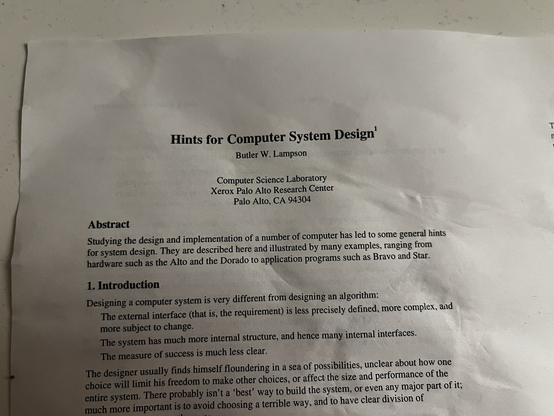How the developers of Bravo at Xerox PARC overcame the limitations of Alto to design the first WYSIWYG editor and make it run efficiently.
Recent searches
Search options
#xeroxparc
I've seen this image a bunch (70s kid programmers at PARC), but now I want to find the source of the posters on the wall behind the computer.
Image source: https://computerhistory.org/blog/introducing-the-smalltalk-zoo-48-years-of-smalltalk-history-at-chm/
ᐅ The Alternate Reality Kit
Remembering Lynn Conway for her pioneering work leading to VLSI and her personal fight against transgender discrimination
https://hackaday.com/2024/06/14/rip-lynn-conway-whose-work-gave-us-vlsi-and-much-more
A remarkable life: "Lynn Conway, leading computer scientist and transgender pioneer, dies at 86".
TIL why the default Ethernet MTU is 1500!
#Ethernet #ComputerHistory #XeroxAlto #XeroxPARC
https://exple.tive.org/blarg/2024/04/24/magic-numbers/
Can Xerox’s PARC, a Silicon Valley Icon, Find New Life with SRI?
"Two research labs known for some of the tech industry’s most important innovations have merged in hopes of recapturing their glory days." -- #JohnMarkoff
Dealers of Lightning: Xerox PARC and the Dawn of the Computer Age by Michael A. Hiltzik (1999)
Text instead of screenshots: https://cohost.org/lurkjay/post/5166294-dealers-of-lightning
“The destiny of computers is to become interactive intellectual amplifiers for everyone in the world pervasively networked worldwide”.
https://www.quora.com/What-made-Xerox-PARC-special-Who-else-today-is-like-them/answer/Alan-Kay-11
Today’s find, from under my bed, from I-don’t-know-how-many-thousand years ago, while looking for my new cat #papers #xeroxparc
@jaruzel @StefanoGaivota interesting! To me, #retrocomputing covers early #eightbit (and #sixteenbit) personal computers, and #vintagecomputing covers #mainframe, #minicomputer and #workstation machines (the latter category being composed of #LispMachines, graphical #unix workstations and of course the #XeroxParc machines).
thinking about the magic ingredients that foster #tech #innovation. #XeroxPARC, #BellLabs, and #MIT's #TMRC appear frequently in the annals of #history - at least those I've read.
The #question is - how do we create such centers of innovation?
I'm still putting it together but I suspect there are at least four:
1 Time- Insane and copious amounts of it
2 Community- Multiple individuals who interact syngeristically
3 Space- A shared space for innovation to occur
4 Equipment- Raw materials
1/5
The decisive influence of women on the development of #LispMachine processors and #Scheme in general is criminally under-discussed:
"We had heard that Lynn Conway from Xerox and Carver Mead from Caltech were making real progress on making it possible for people who were not at a chip-fab facility to specify chips for experimental designs. In the Spring of '78 we invited Lynn Conway to teach the class on #VLSI design that she was working on with Carver Mead. Just a few years earlier Guy L. Steele Jr., (then my graduate student) and I invented a simplified but elegant version of the #LISP family of languages that we called Scheme. Guy and I wrote a number of internal memos (Lambda the Ultimate...) that later became famous. Guy enrolled in Lynn's class. For his term project he designed and fabricated a direct interpreter for Scheme, called Scheme-78. It didn't quite work (because of three missing wires); it didn't have a garbage collector; and it was too small to do anything impressive; but it encouraged us to try again. Over the next few months Guy Steele, Jack Holloway, and I designed a new interpreter that we thought could actually be run on a real memory and tested with real programs. I designed the register array, Guy and I developed the microcode. Jack made a PLA generator that could hold the microcode, and we roped Alan Bell of #XeroxPARC into assembling the Scheme-79 Chip. We pulled this off in a few man-months of time and it worked! Scheme-79 had a mark-sweep #GarbageCollector with a Deutsch-Schorr-Waite mark algorithm and a two-finger compacting sweep. It also had a two-level microcode: The main PLA contained rather high-level microcode instructions that were further elaborated by a nanocode PLA that operated the register array.
Further encouraged, I started a new project to make a chip that was actually big enough and fast enough to be useful to run real research programs. This was the Scheme-81 chip. It was a 32-bit machine, with 6 bits of type code and 26 bits of address. It had microcode support for everything required to make a Scheme computer operating system, including a stop-and-copy garbage collector, a coprocessor bus, and an interrupt system. For Scheme-81 the microcode was written by Richard Stallman, Chris Hanson, and me. (Steele had graduated and moved on to CMU as faculty.)"
- Sussman
#WomenInTech #TransPride #lgbt
https://www.artsy.net/article/ruse-laboratories-gerald-jay-sussman-creator-of-scheme
A great paper from 2004 by Richard P. Gabriel (Lucid, Inc.), Jon L White (ditto), Daniel G. Bobrow (Xerox PARC) that explains how Common Lisp Object System integrates functional and object-oriented programming: https://dreamsongs.com/Files/clos-cacm.pdf
https://youtu.be/pQocN_c2uLI
The Xerox Thieves, Steve Jobs and Bill Gates. #Xerox #XeroxPARC #GUI
All about Xerox PARC from The Chip Letter.
PARC is one of the richest slices of computing history. And the mentioned Hiltzik book is one of the best computing history books I've read.
https://thechipletter.substack.com/p/chip-letter-links-no-21-xerox-parc
I intervjuet forsøker Kristen Nygård å forklare objektorientert programmering (#OOP).
I tillegg til Ole-Johan Dahl så nevnes Alan Kay, Xerox PARC, #SmallTalk og Apple Lisa (skrevet som LISA). Endel unøyaktigheter er det i teksten, f.eks. Alan Kay skrev ikke SmallTalk alene, men det er vel ikke så galt til å være et reklameblad.
happy 40th birthday #AppleLisa. not many were sold, and it was discontinued a few years later. retail that US D 9,995.
https://en.m.wikipedia.org/wiki/Apple_Lisa
!
#Apple #GUI #XeroxPARC #SteveJobs #Macintosh


 Mike Amundsen
Mike Amundsen 